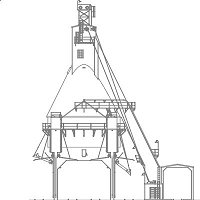
STEAM OPERATIONS
OF THE
CHESAPEAKE &OHIO RAILWAY
AT
by
William E. Simonton, III
|
Home |
Steam Operations |
Drawings |
Typical Heavyweight Passenger Car Consists
1940's |
Contact |
| Numbered Structures | A.F.E. Map Revisions | Articles |
Notes | Things to Come | What's New | Photos |ROY C. LONG ARTICLE
ON THE
CONSTRUCTION OF THE
800 TON F-M COALDOCK
A NEW COAL BIN FOR HINTON
Hinton Daily News September 21, 1993
In 1929 at the height of the depression, the C & O Railway Company expended $363,000.00 on a new coal tipple at Hinton, W. Va. This was a huge expenditure but one that served the company well until the end of steam power. It also served to sand diesel power for several years following the demise of steam. Prior to 1929, the old style coal tipple was in use and located just west of the roundhouse near the front of Eighth Avenue.
During this period of time I was a grade school student at Moss Run, Va., and knew nothing about Hinton, W. Va., much less the railroad at that place.I consulted a friend, and long time railroader, Mr. J. E. "Shorty" Payne for some information about the old coal station. Shorty's father, Mr. J. E. Payne, was a trusted locomotive engineer pulling first class passenger trains between Hinton, W. Va., and Huntington, W.Va., for many years. Shorty went to work in 1926 as a brakeman and wound up his railroad career as a conductor on manifest trains running between Hinton, W.Va., and Russell, Ky.
He advised me the old tipple was of wooden construction, built on a high trestle, covered with shed and was able to accommodate six or eight loads of coal at a time. When time came to replenish the coal supply in the coal tipple, the yard engine would take the loads for the tipple to the tipple track switch near 12th Avenue. The crew shoving the loads would have to make a run for the steep grade in order to shove them up the steep trestle incline to get the loads in position under the coal holding shed ro be unloaded. It was a hard climb to reach the tipple. With engine throttle wide open, smoke and red hot cinders bellowing from the stack, the little Consolidation yard engine would be barely moving by the time they reached the entrance of the tipple. Once the loads were placed, the coal was dumped into the holding bin directly under the coal bin track. A service track was adjacent to the coal bin where coal was supplied through chutes by gravity into the coal tender of road engines. Sand was supplied at the same time by hand.
A new coaling station for Hinton had been in the plans for construction ever since the big H-7s were placed in service. Business had increased tremendously and the yard was always congested due to the delay in getting the engines ready again for road service.
Work on the new coaling station near the foot of 9yj Avenue finally got underway in early spring of 1929 and was completed for service in late October 1929. The entire plant layout was designed and constructed by the Fairbanks Morse Company of Chicago Il., who were specialists in the design and erection of coaling stations for railroads throughout the United States. This was the third coal bin for the C & O R'y designed and built by Fairbanks Morse Company, the other two were located at Richmond, Va., and Stevens, Ky.
The new coaling station had a holding capacity of 800 tons and was built of reinforced concrete throughout. Coal was received in cars at the unloading platform and dumped into a receiving hopper. Elevating machinery, electrically controlled, then lifted the coal to the top of the bin. The coal then remained in the bin until drawn out for use of the locomotive. Electric motors performed all of the work incidental to the operation of the structure. A total of eight engines could be serviced at one time by three employees where it took six to eight at the old coal bin.
Owing to the height, the new structure was used for another duty. At the very top, four large floodlights were installed flooding the yard with light, a great improvement aiding the men as they performed their work.
In making plans for the new facility, company officials estimated a large amount of money saved as the work could be performed much quicker getting road engines back in hauling service.
The new coaling station was part of a $1,800,000.00 improvement program for Hinton shops and yards. In addition to the new coal bin, now standing as a lonely monument to better times, work was being done by John W. Cowper Company of Buffalo, N.Y., extending the stalls at the roundhouse for larger engines. New pits were put in and the building bricked which work was finished during December 1929.
For years the atmosphere in that part of town was filled with smoke and cinders. An inspection of any attic in the area will attest to that fact.
The next time you chance to view the concrete monstrosity of a coal bin take a close look at the very top, Just above the lights you will see a blue object, the highest of all objects, on the bin. It happens to be a workers hard hat. The day this employee retired, he climbed to the top and left his protective hat either by mistake or on purpose. What do you think?
Reprinted with permission.